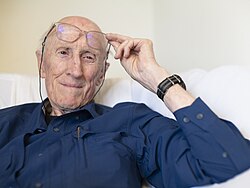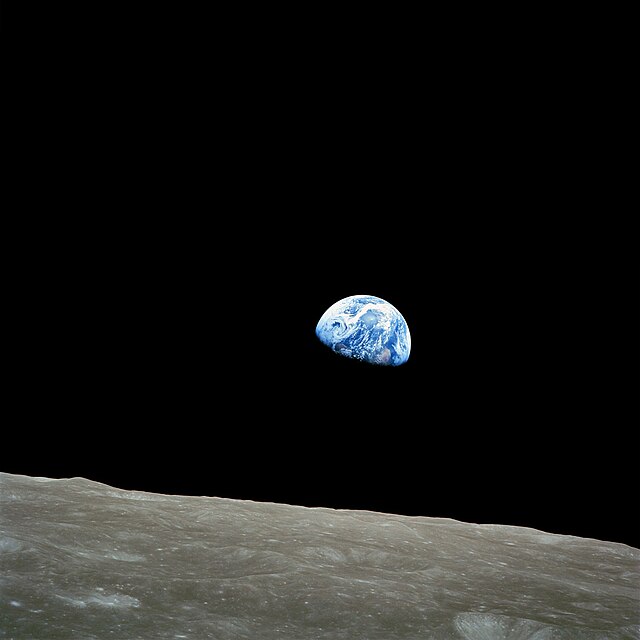Loading AI tools
American writer (born 1938) From Wikipedia, the free encyclopedia
Stewart Brand (born December 14, 1938) is an American project developer and writer, best known as the co-founder and editor of the Whole Earth Catalog. He has founded a number of organizations, including the WELL, the Global Business Network, and the Long Now Foundation. He is the author of several books, most recently Whole Earth Discipline: An Ecopragmatist Manifesto.
Stewart Brand | |
|---|---|
 Brand in 2020 | |
| Born | December 14, 1938 Rockford, Illinois, United States |
| Alma mater | Stanford University |
| Occupations |
|
| Known for | Whole Earth Catalog The WELL Long Now Foundation |
| Spouse(s) | Lois Jennings (1966–1973) Ryan Phelan (1983–present)[1] |
| Website | sb |
Brand was born in Rockford, Illinois, and attended Phillips Exeter Academy in New Hampshire. He studied biology at Stanford University, graduating in 1960.[2] As a soldier in the U.S. Army, he was a parachutist and taught infantry skills; he later expressed the view that his experience in the military had fostered his competence in organizing.[3] A civilian again in 1962, he studied design at San Francisco Art Institute, photography at San Francisco State College, and participated in a legitimate scientific study of then-legal LSD with Myron Stolaroff's International Foundation for Advanced Study, in Menlo Park, California.[4][5] In 1966, he married mathematician Lois Jennings, an Ottawa Native American.[6]
Brand has lived in California since the 1960s. He and his second wife live on Mirene, a 64-foot (20 m)-long working tugboat. Built in 1912, the boat is moored in a former shipyard in Sausalito, California.[7] He works in Mary Heartline, a grounded fishing boat about 100 yards (90 metres) away.[7] One of his favorite items is a table on which Otis Redding is said to have written "(Sittin' On) The Dock of the Bay" (Brand acquired it from an antiques dealer in Sausalito).[7]
By the mid-1960s, Brand became associated with New York multimedia group USCO and Bay Area author Ken Kesey and his Merry Pranksters. Brand co-produced the 1966 Trips Festival, an early effort blending rock music and light shows, with Kesey and Ramón Sender Barayón. The Trips Festival was among the first Grateful Dead performances in San Francisco. An estimated 10,000 hippies attended, and Haight-Ashbury soon emerged as the epicenter of an emerging counterculture, with the Summer of Love in 1967.[8] Tom Wolfe includes Brand in his 1968 book The Electric Kool-Aid Acid Test.[9]


In 1966, while on an LSD trip on the roof of his house in North Beach, San Francisco, Brand became convinced that seeing an image of the whole Earth would change how we think about the planet and ourselves.[10][11] He then campaigned to have NASA release the then-rumored satellite image of the entire Earth as seen from space. He sold and distributed buttons for 25 cents each,[12] asking, "Why haven't we seen a photograph of the whole Earth yet?"[13] During this campaign, Brand met Richard Buckminster Fuller, who offered to help Brand with his projects.[14] In 1967, a satellite, ATS-3, took the photo. Brand thought the image of our planet would be a powerful symbol; it adorned the first (Fall 1968) edition of the Whole Earth Catalog.[15] Later in 1968, NASA astronaut Bill Anders took an Earth photo,[13] Earthrise, from Moon orbit, which became the front image of the spring 1969 edition of the Catalog. 1970 saw the first celebration of Earth Day.[12] During a 2003 interview, Brand explained that the image "gave the sense that Earth's an island, surrounded by a lot of inhospitable space. And it's so graphic, this little blue, white, green and brown jewel-like icon amongst a quite featureless black vacuum."
In late 1968, Brand assisted electrical engineer Douglas Engelbart with the Mother of All Demos, a presentation of many revolutionary computer technologies (including hypertext, email, and the mouse) to the Fall Joint Computer Conference in San Francisco.[16][17]
Brand surmised that given the necessary consciousness, information, and tools, human beings could reshape the world they had made (and were making) for themselves into something environmentally and socially sustainable.[18]: 42
During the late 1960s and early 1970s, about 10 million Americans were involved in living communally.[19] In 1968, using the most basic approaches to typesetting and page layout, Brand and his colleagues created issue number one of the Whole Earth Catalog, employing the subtitle "access to tools".[18] : 48 Early editions of the Whole Earth Catalog were published by the Portola Institute.[20] Brand and his wife, Lois, traveled to communes in a 1963 Dodge truck known as the Whole Earth Truck Store, which moved to a storefront in Menlo Park, California.[18][page needed] That first oversized Catalog, and its successors in the 1970s and later, reckoned a wide assortment of things could serve as useful "tools": books, maps, garden implements, specialized clothing, carpenters' and masons' tools, forestry gear, tents, welding equipment, professional journals, early synthesizers, and personal computers. Brand invited "reviews" (written in the form of a letter to a friend) of the best of these items from experts in specific fields. The information also described where these things could be located or purchased. The Catalog's publication coincided with the great wave of social and cultural experimentation, convention-breaking, and "do it yourself" attitude associated with the "counterculture".
The Whole Earth Catalog had widespread influence within the rural back-to-the-land movement of the 1970s, and the communities movement within many cities throughout the United States, Canada, and Australia. The 1972 edition sold 1.5 million copies, winning the first U.S. National Book Award in the Contemporary Affairs category.[21]
Steve Jobs ended his 2005 commencement address at Stanford University by acknowledging both Stewart Brand and the Whole Earth Catalog, quoting its farewell message: "Stay hungry. Stay foolish".[22][23]
To continue this work and also to publish full-length articles on specific topics in the natural sciences and invention, in numerous areas of the arts and the social sciences, and on the contemporary scene in general, Brand founded CoEvolution Quarterly in 1974, aimed primarily at educated laypeople.[24] Brand never better revealed his opinions and reason for hope than when he ran, in CoEvolution Quarterly #4, a transcription of technology historian Lewis Mumford's talk "The Next Transformation of Man", in which he stated that "man has still within him sufficient resources to alter the direction of modern civilization, for we then need no longer regard man as the passive victim of his own irreversible technological development".[25]
The content of CoEvolution Quarterly often included futurism or risqué topics. Besides giving space to unknown writers with something to say, Brand presented articles by many respected authors and thinkers, including Mumford, Howard T. Odum, Witold Rybczynski, Karl Hess, Orville Schell, Ivan Illich, Wendell Berry, Ursula K. Le Guin, Gregory Bateson, Amory Lovins, Hazel Henderson, Gary Snyder, Lynn Margulis, Eric Drexler, Gerard K. O'Neill, Peter Calthorpe, Sim Van der Ryn, Paul Hawken, John Todd, Kevin Kelly, and Donella Meadows. In the ensuing years, Brand authored and edited a number of books on topics as diverse as computer-based media, the life history of buildings, and ideas about space colonies.
He founded the Whole Earth Software Review, a supplement to the Whole Earth Software Catalog, in 1984. It merged with CoEvolution Quarterly to form the Whole Earth Review in 1985.[26]
From 1977 to 1979, Brand served as "special advisor" to the administration of California Governor Jerry Brown.[27][28]
In 1985, Brand and Larry Brilliant founded the WELL ("Whole Earth 'Lectronic Link"), a prototypical, wide-ranging online community for informed participants the world over.[29] The WELL won the 1990 Best Online Publication Award from the Computer Press Association.[30]
In 2000, Brand helped launch the All Species Foundation,[31][32] which aimed to catalog all species of life on Earth.[33] The project ceased functioning in 2007, transferring its mission to the Encyclopedia of Life.[31]


During 1986, Brand was a visiting scientist at the MIT Media Lab. Soon after, he became a private-conference organizer for such corporations as Royal Dutch Shell, Volvo, and AT&T. In 1988, he became a co‑founder of the Global Business Network, which became involved with the evolution and application of scenario thinking, planning, and complementary strategic tools.[20] For fourteen years, Brand was on the board of the Santa Fe Institute (founded in 1984), an organization devoted to "fostering a multidisciplinary scientific research community pursuing frontier science". He has also continued to promote the preservation of tracts of wilderness.
The Whole Earth Catalog implied an ideal of human progress that depended on decentralized, personal, and liberating technological development—so‑called "soft technology". However, in 2005, Brand criticized aspects of the international environmental ideology he had helped to develop. He wrote an article called "Environmental Heresies"[34] in the May 2005 issue of the MIT Technology Review, in which he described what he considered necessary changes to environmentalism. He suggested, among other things, that environmentalists embrace nuclear power and genetically modified organisms as technologies with more promise than risk.[35]
Brand later developed these ideas into a book and published Whole Earth Discipline: An Ecopragmatist Manifesto in 2009. The book examines how urbanization, nuclear power, genetic engineering, geoengineering, and wildlife restoration can be used as powerful tools in humanity's ongoing fight against global warming.[36]
In a 2019 interview, Brand described his perspective as "post-libertarian", indicating that at the time when the Whole Earth Catalog was being written, he did not fully understand the significance of the role of government in the development of technology and engineering.[35] In his environmental position, he self-describes as an "eco-pragmatist".[37]
Brand is co‑chair and president of the board of directors of the Long Now Foundation and chairs the foundation's Seminars About Long-term Thinking. This series on long-term thinking has presented a range of speakers, including Brian Eno, Neal Stephenson, Vernor Vinge, Philip Rosedale, Jimmy Wales, Kevin Kelly, Clay Shirky, Ray Kurzweil, Bruce Sterling, and Cory Doctorow. The Long Now Foundation has worked with Jeff Bezos to build the 10,000 Year Clock.[38]
Brand is the subject of the 2021 documentary film We Are As Gods.[39]
Stewart Brand is the initiator or was involved with the development of the following:
Seamless Wikipedia browsing. On steroids.
Every time you click a link to Wikipedia, Wiktionary or Wikiquote in your browser's search results, it will show the modern Wikiwand interface.
Wikiwand extension is a five stars, simple, with minimum permission required to keep your browsing private, safe and transparent.